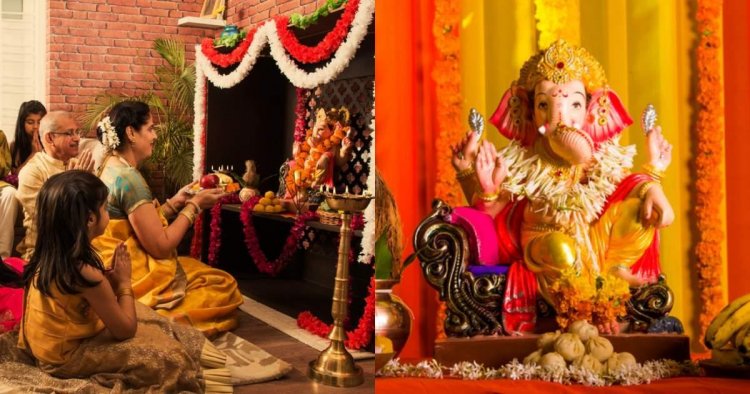Know How to Perform Ganesh Chaturthi Puja at Home

Ganesh Chaturthi is marked by various cultural events, brotherhood, getting together for artis, pooja, numerous religious functions, and the general atmosphere is marked by grand festivities. Sweets, sweetmeat, delicious preparations, hurried and hectic kitchen activity is the hallmark of the 10 days. In various parts of the country, it is referred to as – “Ganpati Basla” (in Marathi it means- One has seated the Lord at home).
We are performing Ganesh Chaturthi Maha Puja & Yagna on the auspicious occasion of Ganesh Chaturthi on 22nd August 2020. The person who fasts on Masik Ganesh Chaturthi or Vinayaka Chaturthi is blessed by Lord Ganesha and is bestowed with happiness as well as prosperity. The Puja gives success in business and career. The devotee attains mental peace and lives a prosperous and happy life. Ganesh Puja and Yagna on Masik Ganesh Chaturthi are considered as the best days of the month to worship Lord Ganesha.
Lord Ganesha is the God of intellect, wisdom, knowledge and auspicious beginnings. It is believed that if on the said day a devotee of Lord Ganesha fast, does penance and worships Lord Ganesha then all his desires get fulfilled. Puja and Vrat that are observed on Chaturthi are very rewarding and devotees get blessed with spiritual upliftment, happiness, the fulfilment of desires, material progress and much more by the grace of Lord Ganesha.
The Ganesh Chaturthi 2020 Puja Muhurut to bring the Vigraha / Idol home is during the Shubh, Labh or Amrit Choghadiya. If you intend to bring Ganpati ji one day before, i.e. on the 21st August 2020, the Labh time is between 07:56 to 11:06 and the Shubh time is 12:41 to 14:16. Ganpati ji can also be brought home (Avahana or Welcome) during the Shub time which is between 21:52 to 23:11. The Muhurut for evening time would be the Amrit time which is between 17:27 to 19:02. Please note these Timings are as per panchang of Mumbai, India.
The Ganesh Staphna (installation of the Idol) on Ganesh Chaturthi day, i.e. on 22nd August 2020 can be done at Shubh time between 07:56 to 09:31 or Labh Time i.e. between 14:16 to 13:51. Ganesh Pooja is preferred during Madhyanhana on Ganesh Chaturthi as it is believed that Lord Ganesh was born during Madhyahana Kaal which is between 14:16 and 13:51. The Muhurut time specified above is the best Muhurut to perform the Ganesh Puja and to perform any work.
Ganesh Chaturthi is celebrated with great devotion all over India. People bring home murtis (Idols) of Lord Ganesha and celebrate the festival by worshiping the Lord in a special way for a day and a half, 3 days, 5 days, 7 days or 11 days depending on the family tradition and commitment of each individual.
On the last day of worship, the idol is taken out in a colourful and musical procession to be immersed traditionally at a beach.
Ganesh Chaturthi 2020 date and puja mahurat
Madhyahna Ganesha Puja Mahurat – 11:06 AM to 01:42 PM
Duration – 02 Hours 36 Mins
Ganesha Visarjan on Tuesday, September 1, 2020
Time to avoid Moon sighting – 09:07 AM to 09:25 PM
Duration – 12 Hours 19 Min
Chaturthi Tithi Begins – 11:02 PM on Aug 21, 2020
Chaturthi Tithi Ends – 07:57 PM on Aug 22, 2020
Ganesh Visarjan Dates
Ganesh Chaturthi Puja observes in a special way for a day and a half, 3 days, 5 days, 7 days depending on the family tradition and culture. This varies from place to place. Accordingly, Ganesh Visarjan dates for 2020 are
1 and half days Visarjan: Sunday, August 23, 2020
3 days Visarjan: Monday, August 24, 2020
5 days Visarjan: Wednesday, August 26, 2020
7 days Visarjan: Friday, August 28, 2020

Lord Ganesha Symbolism
Lord Ganesha has the head of an elephant, four hands joined to a large belly with each hand holding its own symbolic object. Lord Ganesha holds a Trishul or trident in one hand to punish, and Ankush or goad (made from his very own broken tooth) in another to control the mind, a lotus in the third to bless the well-being of humanity, and a rosary (which is sometimes replaced by modaks, his favourite sweet) in the fourth for happiness.
Some say that his large ears signify listening to God, while his large forehead is to develop great intellect. His large stomach shows his capacity to empathize with the troubles of devotees, while his long trunk symbolizes his deep scriptural wisdom.
All we know that modak is most favourite to Lord Ganesha. So, he is also called as ‘Modakpriya’. Here are some flowers that you must consider offering him:
Red Hibiscus is a favourite flower of Lord Ganesha. For all-round prosperity and destruction of enemies, one should offer hibiscus.
Downy Jasmine (Kunda): Separation among family members, long standing court cases get resolved.
Blue Gokarna (Clitoria Ternatea): For early marriage one must make this flower offering.
Marigold: Offering of this flower cures one of chronic diseases and gives good health.
Erukku Flowers: Divinities attract Flowers and as they have the ability to remove negativity from a person’s soul. Lord Ganesha got a strong feeling of pleasure with marigold and erukku flowers.
Ganesh Chaturthi puja vidhi performs with all sixteen rituals along with puja Mantras. There are four main rituals done by the Ganesh Pandals for Ganesh Puja.

Pranapratishhtha – the process of infusing the deity into a murti or idol.
Shhodashopachara – 16 forms of paying tribute to Ganesha.
Uttarpuja – Puja after which the idol could be shifted after its infusion.
Ganpati Visarjan – immersion of the Idol in the river.
Ganesh Chaturthi Puja at Home
First of all, establish the idol of Lord Ganesha at your home. As per Vastu the northeast corner of the house associates with bringing prosperity and happiness. Select the northeast corner of your house for Ganesh Puja which should be clean and calm.
Clean the house and sprinkled with ganga water; especially in the place where the Idol of Lord Ganesha is to be placed.
Arrange a bright dress for the idol and place diyas for the puja.
Place the Kalash on the shrine and offer the deity with flowers and different food items.
Arrange a puja thali by the mentioned contents to perform the puja; – Red Altar Cloth, Brass Kalash with Nariyal, Hindu Tilak, Gomutra, Gangajal, Rosewater, Diya, Ghee, Dhoop stick, Supari (betel nut), Clove, Cardamom, Darbha Grass (single), Puja Coin (German silver), Akshat, Panchmeva, Janeu, Mouli, Kapus Vastra, Honey, Attar, Kapur, Kharik, Badam, Raw Haldi.
Celebrating at home, you need to have some essentials to perform the puja. You can call a pundit to perform the Pranpratishtha or you can do it yourself. Here is how -
1. Clay idol of Ganesha
2. Red flowers - preferably hibiscus
3. Durva grass
3. Modak (Sweet rice dumplings) or any sweet will do
4. Coconut
5. Sandalwood paste
6. Janve (Sacred white thread)
7. Betel leaves
8. Raised platform
9. Ghee lamp
10. Kalash
Step by step at-home ritual:
1. Clean your house
2. Take a bath
3. Fill the Kalash with water and decorate it with Betel leaves. Put coconut on top of it.
4. Put the Ganesh idol on the raised platform
5. Put the Janve (Sacred thread) on the idol's left shoulder.
6. Deck the idol with garlands and red flowers.
7. Offer Durva grass
8. Put tilak of Sandalwood paste on the idol
9. Recite the following Mantra from Rigveda to do the Pranpratishtha
"ganananh tva ganapatim havamahe kavim kavinam – upamashravastamam jyeshhtharajam brahmanan.h brahmanaspata A nah shrivnvannutibhih sida sadanam" (Rig Veda 2.23.1)
"ni shhu sida ganapate ganeshhu tvamahurvipratamam kavinam na rite tvat.h kriyate kinchanare mahamarkam maghavan.h chitramarcha" (Rig Veda 10.112.9)
10. Light the ghee lamp and sing the aarti
11. Offer the Modak and pray.

Rules for performing puja at home are always flexible. Strict rituals are meant for temples and for Vedic pundits who are trained to perform them. All you have to do is pray to Ganesha with a clean and calm mind.
Celebration in Different Regions Ganesh Chaturthi brings people of all religion, caste and creed together. Ganesh Chaturthi is celebrated all over India as well as abroad. But it is most famous in Indian state Maharashtra. In Mumbai alone, around 150,000 statues are immersed annually.
Om Ganeshay Namah!















































